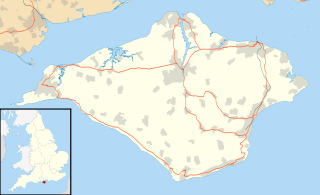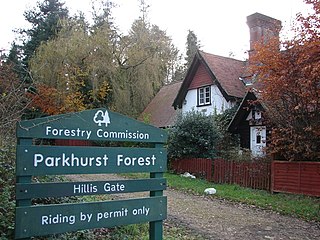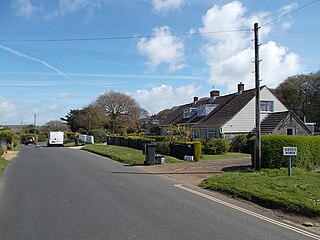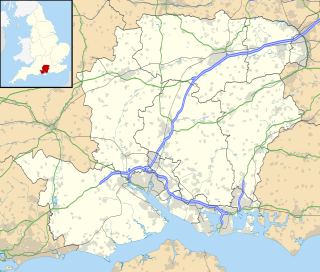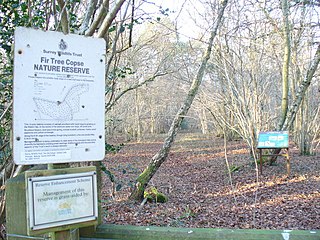
Borthwood Copse, near Sandown, Isle of Wight, England is a piece of woodland owned by the National Trust and is one of the numerous copses which make up part of the medieval forest which covered most of the eastern end of the Island. Borthwood Copse sits on the outskirts of Newchurch, and is close to the neighbouring hamlet of Apse Heath and the villages of Queen's Bower and Alverstone. Borthwood Copse was originally a royal hunting ground. [1] It was bequeathed to the National Trust in 1926 by Frank Morey. He had purchased it a few years earlier to preserve it for wildlife. Subsequent additions have added to the land and it now covers a total of 60 acres (240,000 m2).

Sandown is a seaside resort and civil parish on the south-east coast of the Isle of Wight, England, with the town of Shanklin to the south and the settlement of Lake in between.

The Isle of Wight is a county and the largest and second-most populous island in England. It is in the English Channel, between 2 and 5 miles off the coast of Hampshire, separated by the Solent. The island has resorts that have been holiday destinations since Victorian times, and is known for its mild climate, coastal scenery, and verdant landscape of fields, downland and chines.

England is a country that is part of the United Kingdom. It shares land borders with Wales to the west and Scotland to the north-northwest. The Irish Sea lies west of England and the Celtic Sea lies to the southwest. England is separated from continental Europe by the North Sea to the east and the English Channel to the south. The country covers five-eighths of the island of Great Britain, which lies in the North Atlantic, and includes over 100 smaller islands, such as the Isles of Scilly and the Isle of Wight.
There are some ancient oaks, and a distinctive grove of beech trees which stand amongst glades of coppiced sweet chestnut and hazel. The woodland is one of the very few examples of working coppice with standards which can be seen on the Isle of Wight. A bridleway and many smaller paths lead through the woodland, which is open to the public. It is particularly popular with visitors in the autumn with its vivid colours and, in the springtime, when carpeted with bluebells. Borthwood Copse is one of the countless locations in the Eastern Isle of Wight that are home to large numbers of Red Squirrels.
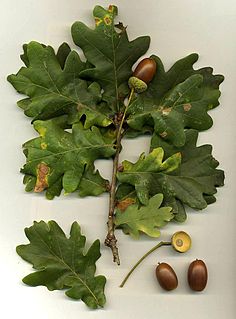
An oak is a tree or shrub in the genus Quercus of the beech family, Fagaceae. There are approximately 600 extant species of oaks. The common name "oak" also appears in the names of species in related genera, notably Lithocarpus, as well as in those of unrelated species such as Grevillea robusta and the Casuarinaceae (she-oaks). The genus Quercus is native to the Northern Hemisphere, and includes deciduous and evergreen species extending from cool temperate to tropical latitudes in the Americas, Asia, Europe, and North Africa. North America contains the largest number of oak species, with approximately 90 occurring in the United States, while Mexico has 160 species of which 109 are endemic. The second greatest center of oak diversity is China, which contains approximately 100 species.

Fagus sylvatica, the European beech or common beech, is a deciduous tree belonging to the beech family Fagaceae.
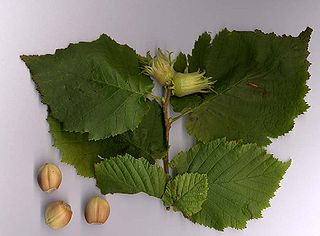
Corylus avellana, the common hazel, is a species of hazel native to Europe and western Asia, from the British Isles south to Iberia, Greece, Turkey and Cyprus, north to central Scandinavia, and east to the central Ural Mountains, the Caucasus, and northwestern Iran. It is an important component of the hedgerows that were the traditional field boundaries in lowland England. The wood was traditionally grown as coppice, the poles cut being used for wattle-and-daub building and agricultural fencing.
Owing to its position on the downs, much of Borthwood Copse is hilly, and in wet weather the soil often becomes waterlogged and marshy, making travel through the copse on foot difficult.
Within the wood is a viewpoint looking east from where you can catch a glimpse of Culver Down and the sea. As the copse climbs a small hill, Bembridge Windmill can be seen in the distance through the downs on clear days.

Culver Down is a chalk down to the north of Sandown, Isle of Wight. It is believed that its name derives from "Culfre", which is Old English for dove.

Knowle Mill, better known today as Bembridge Windmill, is a Grade I listed, preserved tower mill at Bembridge, Isle of Wight, England.
Wildlife includes dormice, red squirrels, [2] a wide range of bats, and many invertebrates.

Bats are mammals of the order Chiroptera; with their forelimbs adapted as wings, they are the only mammals naturally capable of true and sustained flight. Bats are more manoeuvrable than birds, flying with their very long spread-out digits covered with a thin membrane or patagium. The smallest bat, and arguably the smallest extant mammal, is Kitti's hog-nosed bat, which is 29–34 mm (1.14–1.34 in) in length, 15 cm (5.91 in) across the wings and 2–2.6 g (0.07–0.09 oz) in mass. The largest bats are the flying foxes and the giant golden-crowned flying fox, Acerodon jubatus, which can weigh 1.6 kg (4 lb) and have a wingspan of 1.7 m.
The view point is called Kite Hill.



